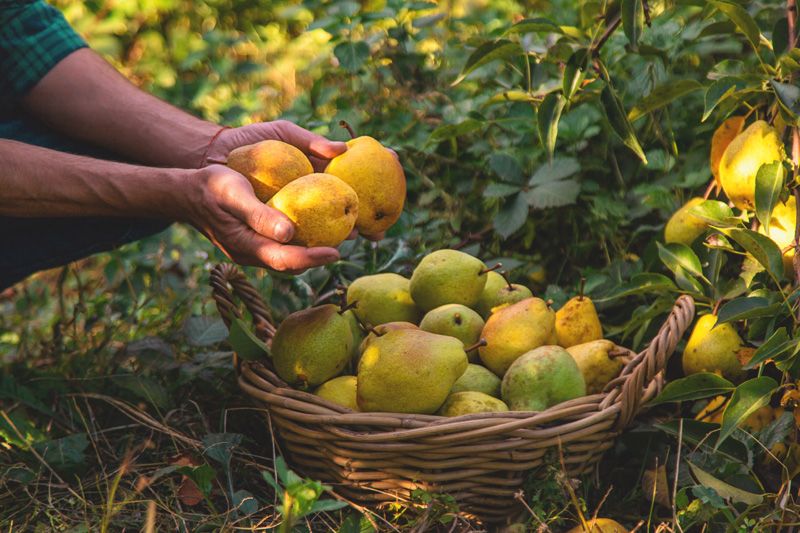Growing Pears
Pears are the easiest to grow fruits. As a result, they are less susceptible to diseases and pests, making them an excellent choice for gardeners. In addition, pears are hydrating, fresh, and delicious fruits. Pears require cross-pollination to produce well; if you don’t have another variety to cross with, it will not produce very well.
Health Benefits
- Excellent source of dietary fiber. Eating pears can also reduce the risk of stroke by up to 50 percent.
- The pectin in pears is diuretic and has a mild laxative effect. Drinking pear juice regularly helps regulate bowel movements.
- The antioxidant nutrients in pears are critical in building up your immune system.
- Pears contain a high level of boron. Boron helps the body to retain calcium, thus prevents or retards osteoporosis.
- You can get a quick and natural energy source from pear juice, mainly due to its high fructose and glucose levels.
- Pears have antioxidant and anti-carcinogen glutathione, which helps prevent high blood pressure and stroke.
- The high vitamin C and copper content act as good antioxidants that protect cells from damages by free radicals.
Planting Pear Tree
Selecting Variety
Almost all pears require cross-pollination from a second cultivar or variety that blooms at the same time. The exceptions are Bartlett, Red Bartlett, in the dry west, and Kieffer and Turnbull. Choose types that overlap your flowering period. This means that both early and late varieties are unlikely to be cross-pollinated. Plant at least two or even three pear trees to ensure pollination.
Selecting Site
Most fruit trees do their best in a sunny location, with good air circulation and soils that are 4 to 5 feet deep and well-drained. But we need soils 6 feet deep for apples and pears. Plant your pear tree in full sun as much as possible to decrease the chances of disease attack. The best soils are fertile, slightly acidic sandy loams, free from alkali or salinity. Avoid sandy, clayey, or shallow soils, although pears may tolerate clay or wet soils better than other fruit trees.
How to Plant?
You need to dig about two times the root ball’s diameter that gives you a nice hole so that the roots can move freely throughout that hole. Loosen up your soil up to 6 feet. Make sure that the original soil level of the pot is equal to the ground level. Don’t backfill the hole with compost and fertilizer because as soon as the roots have extinguished all the nutrients and taken up all the perfect soil, they won’t be encouraged to move throughout the rest of the ground, and you will end up with a stressed plant. Don’t stake your tree because it makes your plant weaker.
Care
- Water your plants well during the first few days and on dry days to help your pear tree form a solid and healthy structure.
- Mulch your plant as it can take your garden to the next level by retaining soil moisture and preventing weeds from growing.
- Prune your trees as this helps increase the growth and overall health of the tree.
- Use more fertilizer than usual if you notice the leaves turning pale green or yellow.
Harvesting Pears
You have to understand pears to harvest them at the right time. Pears are unique fruits; they do not ripen on the tree. If you let them ripen on the tree from the inside of the fruit to the outside, it will be completely mushy, overripe, and inedible. So pick the pears when they are ripe, but not when they are overripe; they should ripen indoors at temperatures between 55 and 75 degrees. The ripening time for each variety of pear is different, so make sure you understand which type you have. It can go from 4 to 10 days.
If you are not sure about the fruit, take a good sample of the fruit and bring it inside and let it ripen. When harvesting, give your pear a soft touch, and they will fall off immediately. If the pears are not ripe, they do not shed very quickly; if not, leave them for a week longer.
Pest, Disease and Their Management
- Blossom Blast(Pseudomonas syringae)
A bacteria called Pseudomonas syringae causes blossom blast disease in pear trees. Symptoms include brown flowers, leaf spots, twig dieback, and bark lesions. The bacteria produce a toxin called syringomycin, which damages plant tissue.
Management
Cut it at least 8 inches below the burn infection and clean your scissors with bleach to kill bacteria. To prevent the spread of disease, spray for small sucking insects like aphids and leafhoppers.
- Pear Decline Disease (Candidatus Phytoplasma pyri)
Candidatus Phytoplasma pyri causes pear decline. It is marked by wilting and abnormal red leaves at the top of the tree. The foliage spread reduces in size, and a brown line is present in the phloem tissue.
Management
There is no effective treatment for this disease. You can only overcome this by using resistant varieties.
- Pear Scab Disease(Venturia pirina)
A fungus called venturia pirina causes scab disease in pear trees. Symptoms include spots that appear on fruits, flowers, and stems. The spots gradually grow and eventually crack the tissue, resulting in scabs.
Management
Spray a mixture of lime and sulfur to prevent the spores from activating. You can also combine chemical and natural operations to control pear scabs in warm, humid areas during flowering and fruiting.
- Vein Yellows Disease(Vein Yellows Virus)
Vein yellows disease is caused by the veins yellows virus, which produces small yellow spots on leaves. The affected leaves are half the size of typical leaves. A similar strain of the virus, called red mottle virus, produces red spots on pear tree leaves.
Management
Use scions and rootstocks that have been tested and found to be free from all known viruses.
Heat the infected tissue at 37 ° C and then spread it by meristems or shoot tips.

